Thanks to hydroponics, Saudi Arabian agriculture is undergoing a revolution, which provides a long-term solution to climate change and water constraints. This article explores the rising market size and the expenses and procedures involved in starting a hydroponic business. Discover how farming in the desert kingdom will change thanks to this novel approach.
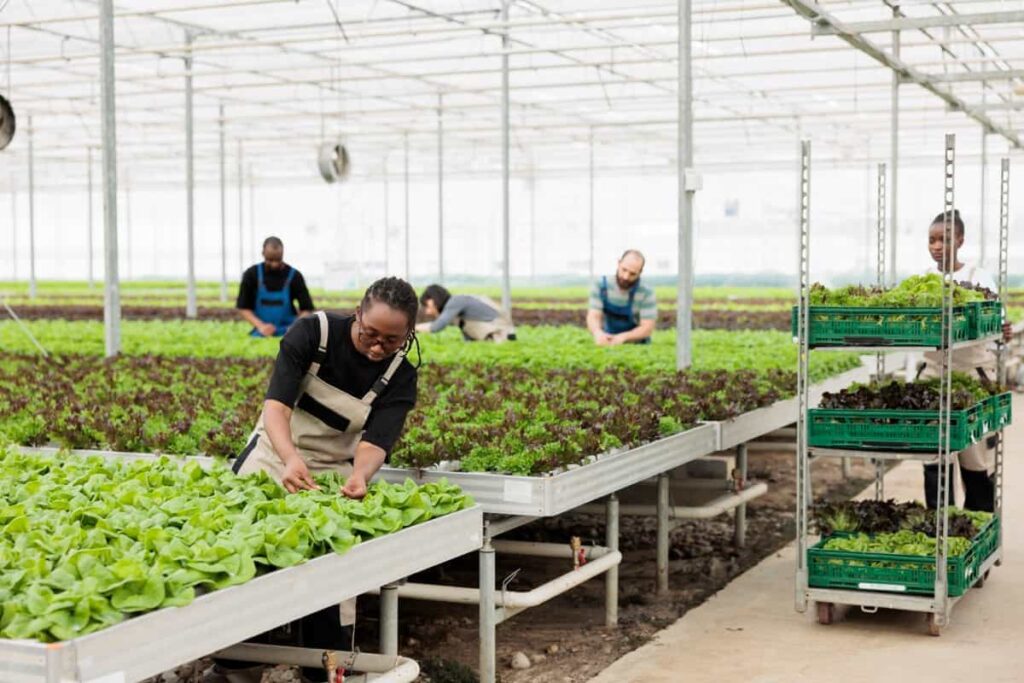
Hydroponic Farming in Saudi Arabia
Hydroponic farming is gaining importance in Saudi Arabia due to its eco-friendly and efficient alternative to traditional soil-based farming. This method uses nutrient-rich water solutions to nourish crops, bypassing the need for traditional soil. It addresses water scarcity by recirculating water resources and eliminating soil-borne diseases and pests, ensuring crop health and security.
Hydroponic farming offers year-round cultivation, mitigating the impact of the scorching desert sun and ensuring a consistent food supply. With precise control over temperature, humidity, and nutrient levels, hydroponic systems yield exceptional crop productivity, often outperforming traditional agriculture. This innovative approach addresses the challenges traditional farming methods face in the arid region.
Cost to Start a Hydroponics Farm in Saudi Arabia
Starting a hydroponics farm in Saudi Arabia requires careful consideration of factors like farm size, location, crops, equipment, labor, maintenance, and market conditions. One of the most common types of hydroponics systems is the nutrition film method (NFT), which employs a thin layer of nutrient solution to feed the plants’ roots in a closed loop. It is one of the most popular kinds of hydroponics systems.
Typically, the plants are grown in either a vertical or horizontal arrangement in plastic pipes or channels. Strawberries, herbs, leafy greens, and other tiny plants are good candidates for the NFT system.An NFT system with a 10,000 plant annual capacity required an initial investment of roughly 75,000 Saudi riyals (SR) ($20,000). The price of the land, greenhouse, tanks, pumps, filters, nutrients, seeds, and other accessories were all included in this.
Every factory had an annual operational cost of roughly SR 0.75 ($0.20), which included labor, maintenance, marketing, water, and energy. Based on an average selling price of SR 15 ($4) per kilogram of lettuce, the revenue was around SR 3 ($0.80) per plant for the year. The annual net profit was approximately SR 22,500 ($6,000).
In case you missed it: Vertical Farming in the UAE and Saudi Arabia: How to Start, A Step-by-Step Guide
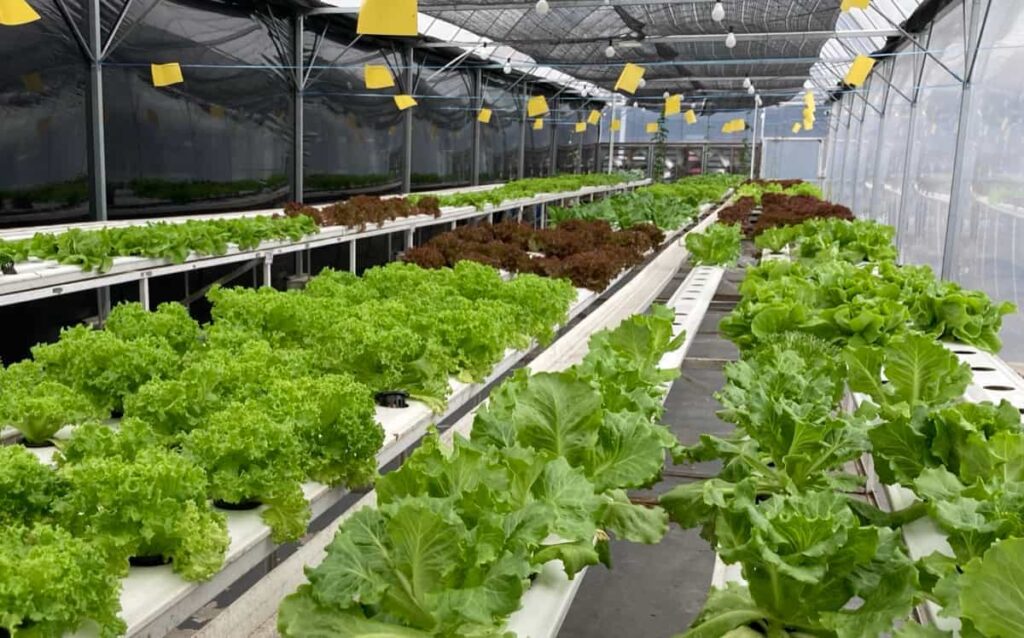
The deep water culture (DWC) system is a different kind of hydroponics system in which the roots of the plants are submerged in big tanks or containers filled with nutritional solutions. Usually, floating rafts or baskets provide the plants with light and air. Leafy greens like lettuce, kale, spinach, basil, mint, and others work well with the DWC method.
A DWC system with a 9,600 plant annual capacity required an initial expenditure of roughly SR 43,200 ($11,520). The price of the land, greenhouse, tanks, rafts, pumps, filters, nutrients, seeds, and additional accessories were included. A plant’s annual running costs, including water, power, labor, maintenance, and marketing, came to approximately SR 1.35 ($0.36).
Based on an average selling price of SR 20 ($5.33) per kilogram of lettuce, the annual revenue per plant was around SR 4.8 ($1.28). The annual net profit was around SR 33,120 ($8,832).These are some potential expenses and profits associated with Saudi Arabian hydroponic gardening. The actual numbers may differ depending on each project’s unique conditions and the market’s state.
How to Set Up a Hydroponics System in Saudi Arabia
Site Selection: Pick a suitable site for your hydroponic farm. Assure people can access basic utilities like electricity and water and are shielded from harsh weather.
Greenhouse or Controlled Environment: To protect your crops from the harsh Saudi Arabian climate, build a greenhouse or controlled environment. It’s critical to have enough cooling and insulating systems.
Hydroponic System Selection: Make sure your chosen hydroponic system will work for you. Drip systems, deep water culture (DWC), and nutrient film technique (NFT) are common choices. Think of things like crop kind, accessible space, and resource availability.
Purchase Equipment: Get the grow lights, pumps, reservoirs, and growing trays, among other essentials. Make sure they fit the climate of the area and meet local norms.
Nutrient Solution and pH Control: To provide your plants the nutrients they need and set up a dependable nutrient solution and pH control system to keep the pH level at the right level.
In case you missed it: How to Build a Cheap Hydroponic System: Low-cost and Budget Friendly Strategies for Beginners
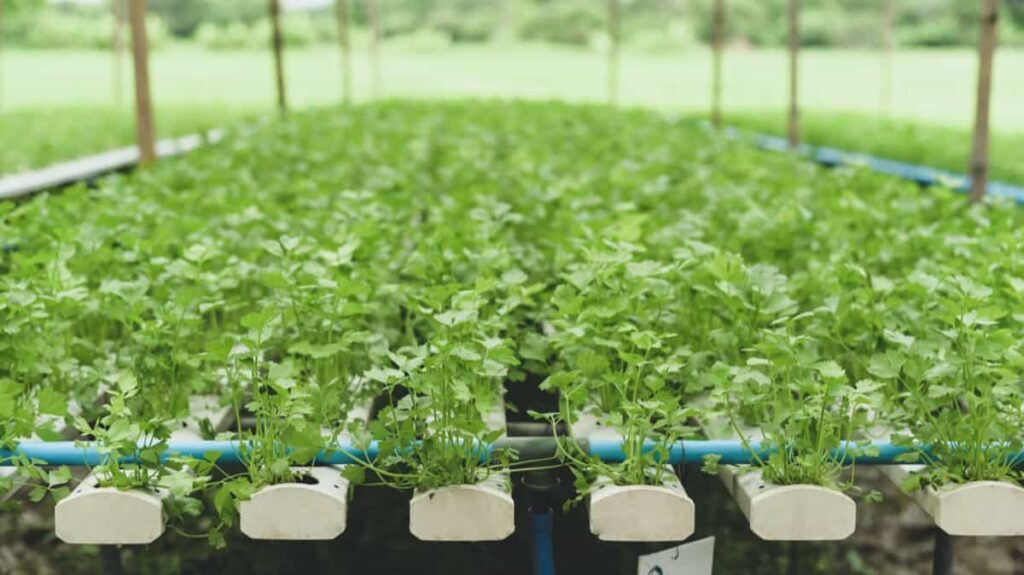
Seedling or Seed Procurement: Find premium seed or hydroponics-suited seedlings. In Saudi Arabia, lettuce, herbs, and tomatoes are popular options.
Planting and Monitoring: Using a hydroponic system, plant crops and monitor the weather, nutrient levels, and plant health.
Pest and Disease Management: To protect your crops from pests and diseases without hazardous pesticides, utilize integrated pest management (IPM) techniques.
Harvesting and Maintenance: To guarantee the effectiveness of your hydroponically grown product, harvest it and do routine system maintenance.
Market Size of Hydroponics in Saudi Arabia
The hydroponics market in Saudi Arabia is anticipated to expand considerably between 2023 and 2030. Data Bridge Market Research’s analysis shows that the market is anticipated to reach USD 386,166.00 thousand by 2030 and is likely to develop at a 15.4% CAGR from 2023 to 2030. The primary driver of the expansion is the increasing recognition of the benefits of hydroponics products across various industries and the growing popularity of these items.
Growing Conditions for Hydroponics in Saudi Arabia
Temperature Control: Saudi Arabia experiences extreme temperatures, especially during the summer. Hydroponic systems thrive in controlled environments where temperature and humidity can be regulated. Greenhouses equipped with cooling and heating systems protect plants from scorching heat.
Water Management: With water scarcity being a significant concern, efficient water management is crucial. Hydroponics drastically reduces water consumption compared to traditional soil-based farming. Recirculating systems and precise control of nutrient solutions enable optimal water use.
Nutrient Solutions: Creating the right nutrient mix is essential. Hydroponic systems rely on nutrient-rich solutions to nourish plants. Tailoring these solutions to match the specific needs of crops is essential for healthy growth.
Light Exposure: Given the high sunlight levels in Saudi Arabia, greenhouses should have shade systems to protect plants from excessive sun exposure, especially during the scorching summer months. Supplemental lighting may also be necessary for consistent year-round production.
Pest Management: Hydroponic systems can help reduce the risk of soil-borne pests and diseases. Nevertheless, vigilant pest management is vital to ensure healthy and productive crops.
Types of Hydroponics Systems Used in Saudi Arabia
Nutrient Film Technique (NFT): NFT is a popular hydroponic system in Saudi Arabia. It involves sloping channels carrying a thin layer of nutrient-rich water over the roots of plants. Water-efficient NFT systems are perfect for growing herbs and leafy greens.
Deep Water Culture (DWC): This technique involves suspending plants with their roots submerged in nutritional solutions. DWC systems frequently cultivate bigger plants, such as cucumbers and tomatoes. Healthy root growth is encouraged by the nutrition solution’s constant oxygenation.
Wick Systems: Wick systems are inexpensive and simple to use. To deliver fertilizer solutions to the plants, they rely on a wick. Wick systems are often utilized in herb and small plant cultivation.
In case you missed it: Idoo Hydroponics Growing System: How to Set Up, Use, and Troubleshoot
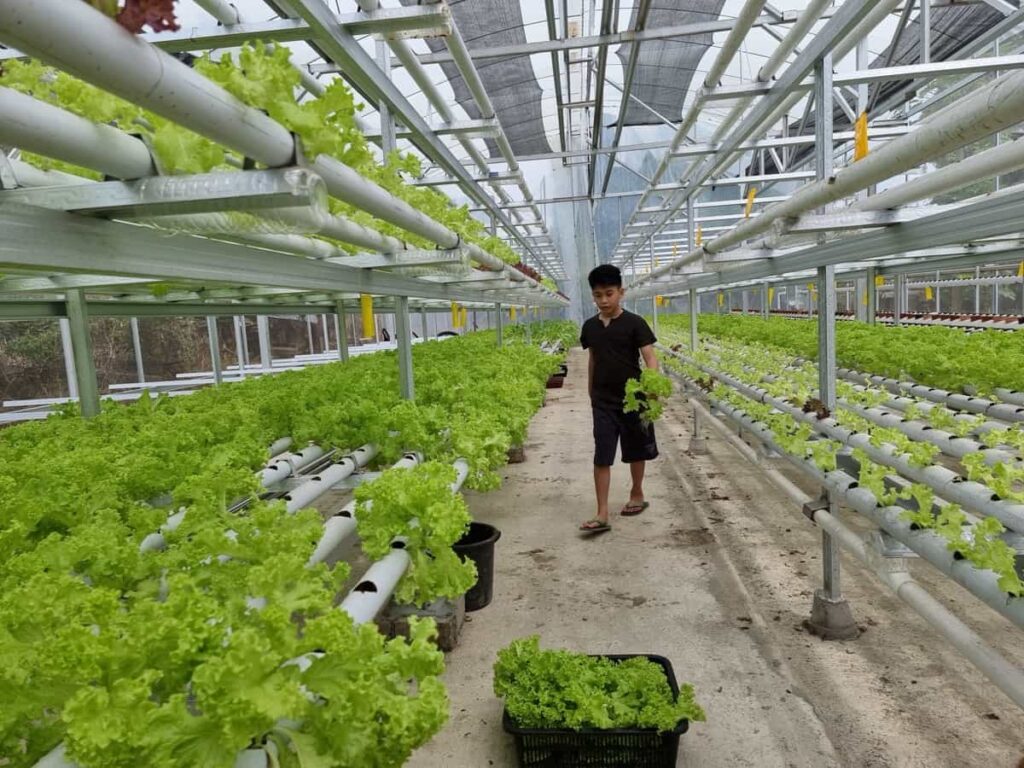
Vertical Farming: Vertical hydroponic systems are gaining popularity in Saudi Arabia as they maximize space utilization. These systems stack layers of plants vertically, using NFT or DWC techniques.
Advantages of Hydroponics in Saudi Arabia
Water Efficiency: Hydroponics performs exceptionally well in a region with limited water resources, such as Saudi Arabia, utilizing up to 90% less water than conventional soil-based farming. It’s a sustainable decision because the closed-loop systems don’t waste water.
Year-Round Cultivation: Hydroponics overcomes the difficulties of the desert climate and severe temperatures to enable crop cultivation all year round. This lessens the effect of seasonal changes by ensuring a steady and dependable food supply.
Increased Crop Productivity: Hydroponics’ controlled settings allow exact control over temperature, humidity, and nutrient levels. This causes the plants to grow more quickly and produces several harvests year-round.
Decreased Soil Erosion: Because hydroponics does not require conventional soil, it inhibits soil erosive processes and degradation. Precious topsoil is preserved, essential for preserving soil fertility over the long run.
Reduction of Pesticides and Herbicides: Hydroponic vegetables frequently require fewer chemical treatments due to their reduced exposure to soil and fewer pests, resulting in cleaner and healthier produce.
Space Optimization: Compact systems and vertical farming provide the best possible use of available space, which makes hydroponics appropriate for urban and small-scale settings.
Resource Conservation: Hydroponics uses less synthetic fertilizer, saving resources and lessening its negative environmental effects.
Challenges of Hydroponics in Saudi Arabia
High Initial Costs: Hydroponic system setup can be costly. For many would-be farmers, the costs—which include specialized technology, equipment, and infrastructure—can be prohibitive.
Energy Consumption: Hydroponic systems need artificial lighting, heating, and cooling in a controlled environment. High energy costs may arise from this, particularly given Saudi Arabia’s intense heat.
Knowledge and Training: Hydroponics requires a particular set of skills and knowledge. To handle nutritional solutions, keep an eye on plant health, and troubleshoot problems, farmers require training that might not be easily accessible.
Climate Control: With Saudi Arabia’s harsh weather, it can be not easy to maintain the ideal climate. Although essential, controlling humidity and cooling can be resource-intensive.
Market viability: In Saudi Arabia, the market for products cultivated hydroponically is still developing. Concerns regarding customer tastes and market demand may be unsettling for farmers.
In case you missed it: Idoo Hydroponics Growing System: How to Set Up, Use, and Troubleshoot
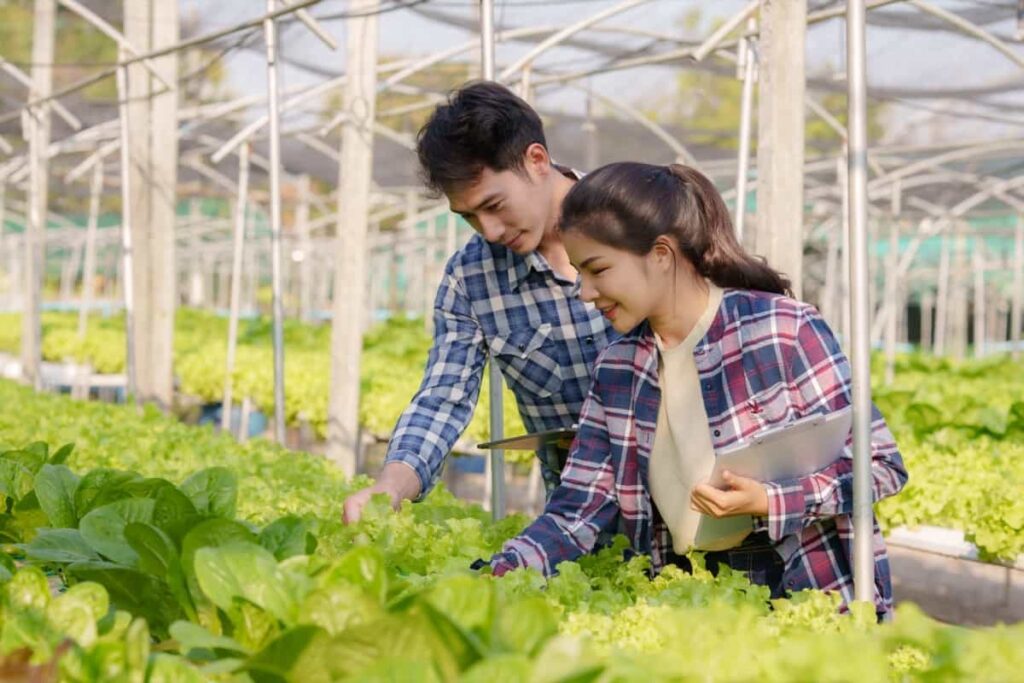
Water Quality: While having a reliable and clean water supply is essential, there are differences in water quality. For hydroponic plants to succeed, proper filtration and treatment are necessary.
Future Outlook of Hydroponics in Saudi Arabia
Hydroponics has a bright future ahead of it in Saudi Arabia, fitting in with the country’s goal of sustainable agriculture. Due to its dry climate and problems with water scarcity, the Kingdom is increasingly using hydroponics to vary its agricultural methods, save water, and guarantee food security.
Through several initiatives, the government has aggressively encouraged farmers and business owners to use hydroponics by providing incentives and subsidies. To foster innovation and technological integration, the Ministry of Environment, Water, and Agriculture has set high goals for the growth of hydroponic farming.
Government Support for Hydroponics in Saudi Arabia
Given the severe weather and lack of water in the nation, the Saudi Arabian government has realized the potential of hydroponics as a sustainable and effective technique for agricultural output. Various programs and regulations have been implemented to encourage and facilitate hydroponic farming.
Research and Development: The government invests in this area to improve hydroponic technologies and techniques. To promote innovation, this involves working with academic institutions and research centers.
Financial Assistance: Farmers implementing hydroponics can apply for grants, subsidies, and other financial incentives. By taking these steps, we hope to lower the initial investment costs and increase accessibility to hydroponics.
Education and Training: The government provides workshops and training programs to teach farmers about hydroponic methods and best practices. This guarantees that farmers possess the skills needed to be successful hydroponic farmers.
Regulatory Support: To guarantee the quality and safety of produce, the government has created rules and guidelines unique to hydroponics. This increases customer trust in crops grown hydroponically.
Frequently Asked Questions (FAQs) on Hydroponics in Saudi Arabia
What Is Hydroponics, And Why Is It Gaining Popularity in Saudi Arabia?
Hydroponics is a method of growing plants without soil using nutrient-rich water solutions. It’s gaining popularity in Saudi Arabia due to its water-efficient nature, allowing cultivation in arid conditions.
How Much Does Starting a Hydroponics Farm in Saudi Arabia Cost To Start A Hydroponics Farm?
Costs can vary depending up on the scale and complexity of the system. Small setups might start at a few thousand dollars, while larger, more advanced farms can require substantial investments.
In case you missed it: How to Grow Broccoli Hydroponically: Nutrients, Grow Time, and Lighting Requirements
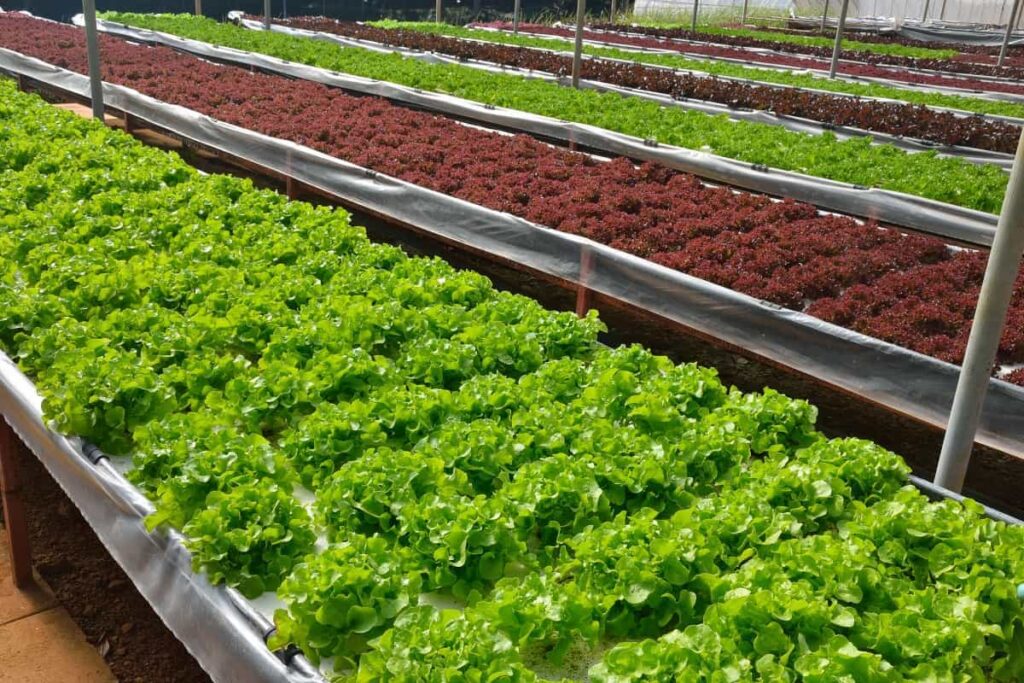
Are There Government Incentives for Hydroponics in Saudi Arabia?
The Saudi government provides support through research funding, financial incentives, education, and regulatory measures to encourage hydroponic farming.
What Crops Can Be Grown Using Hydroponics in Saudi Arabia?
Hydroponics allows for cultivating a wide range of crops, but in Saudi Arabia, it’s often used for growing leafy greens, herbs, tomatoes, cucumbers, and peppers.
Is Hydroponically Grown Produce Safe to Consume?
Yes, hydroponically grown produce is safe to eat. The controlled environment minimizes the use of pesticides, and the produce is often of high quality.
Conclusion
Hydroponics is poised to transform agriculture in Saudi Arabia, offering an eco-friendly solution to water scarcity and extreme climates. With substantial government support, a growing market, and numerous advantages, hydroponic farming is positioned to ensure food security and sustainable agriculture in the Kingdom’s challenging environmental conditions.
- Profitable Village Farming Business Ideas in 2024
- High-Yield Aquaculture: Fast-Growing Fish for Farming
- Effective Fish Pond Construction Techniques for Beginners
- Irrigation and Water Management in Pineapple Farming
- Blossom to Harvest: Mastering Flowering and Pollination in Papaya Farming
- Pig Fattening Essentials: From Selection to Sale for Beginners
- Raising Wagyu Cattle: A Complete Guide for Premium Beef Production
- Soil Types and Their Water Holding Capacity
- Optimizing Irrigation Schedules for Coconut Groves for Enhanced Yield
- Espresso Your Garden: Coffee Grounds for Healthier Acid-Loving Plants
- The Best Soil Mix for Snake Plants: How to Mix Your Own Snake Plant Soil
- Green Thumb Success: Expert Tips for Cultivating Greenhouse Beans All Year Round
- Bloom All Year Round: The Ultimate Guide to Indoor Hyacinth Care
- Eco-Friendly Gardening: How to Make Liquid Fertilizer from Kitchen Waste
- Ultimate Guide to Grow Anise in Pots: Explore Seed Propagation to Harvesting
- Guide to Raising Chester White Pigs: Discover Breed Facts to Growth Management
- Mastering the Elegance: The Ultimate Guide to Weeping Cherry Tree Care, Planting, and Maintenance
- Ultimate Guide to Planting Garlic in Grow Bags: Growing Strategies for Beginners
- How to Fix Spider Plant Leaf-Related Problems: Natural and Organic Remedies
- 10 Reasons Why Your Tulsi Plant is Shedding Leaves: Home Remedies and Solutions
- Optimizing Growth and Yield: The Advantages of Palm Bunch Ash Fertilizer
- Utilizing Neem Oil Extract as a Natural Pesticide for Hydrangea
- From Soil to Harvest: Various Ways in Which Farmers Can Use AI Tools
- Steps to Encourage and Induce Citrus Flowers: A Comprehensive Guide
- How to Fix Snake Plant Leaf-Related Issues: Natural and Organic Remedies
- Transform Your Garden into a Fragrant Oasis with Raat Ki Rani (Night Blooming Jasmine)
- Discover the Ideal Chicken Breeds for Philippine Farms
- How to Create a Poultry Egg Farm Business Plan for Profits
- Grow Lemon Cucumbers Like a Pro: Insider Techniques for Bountiful Yields
- Ultimate Guide to Caring for Your Pink Princess Philodendron: Tips for Thriving Variegation
- Areca Nut Profit Per Acre: Calculating Yield and Cost of Cultivation
- How Kaveri Chicken is Becoming a More Profitable Breed in Indian Backyards
- Transform Your Barn: 9 Steps to Convert a Horse Stall into a Chicken Coop
- Exploring Suffolk Sheep Disadvantages with Limitations and Challenges
- Guide to Solving Potted Lemon Tree Problems: How to Revive Lemon Tree in Containers
- Steps to Encourage Female Pumpkin Flowers: Best Strategies for More Flowers and High Yields
